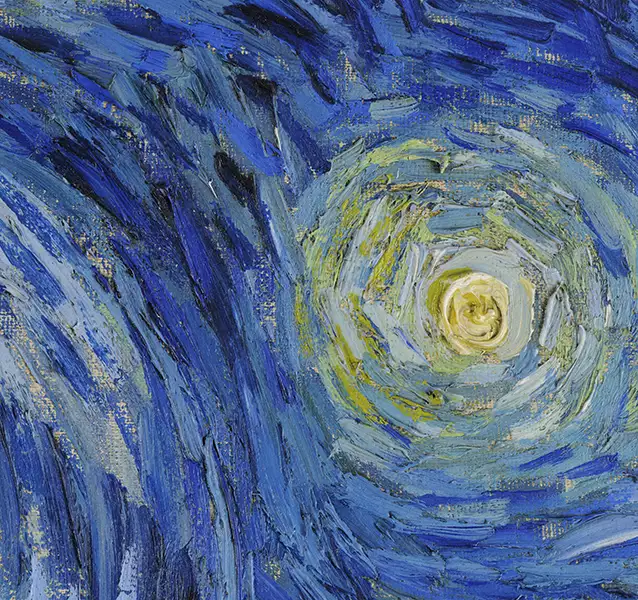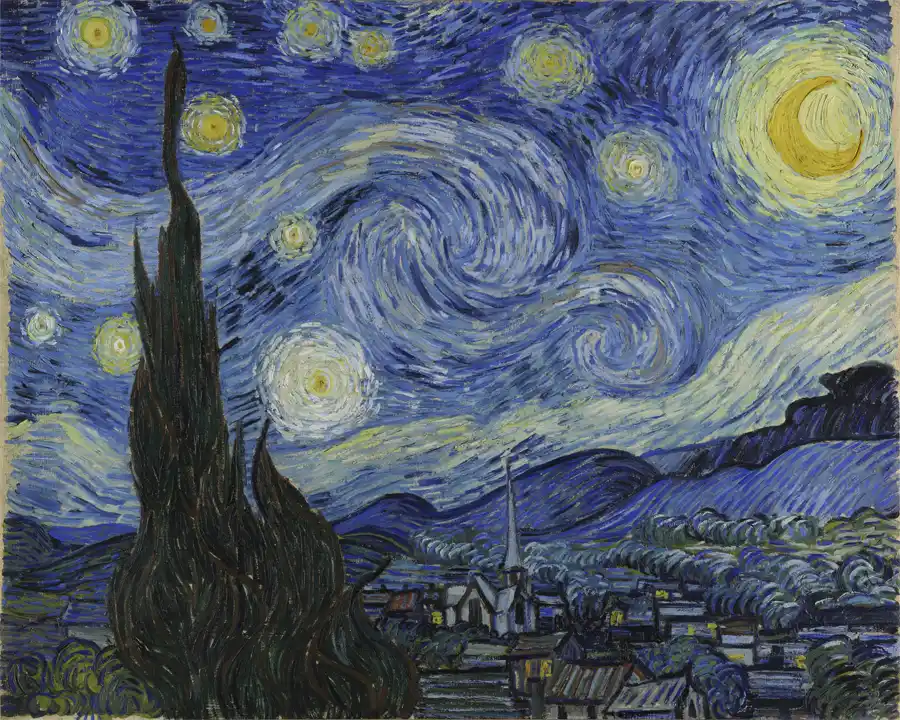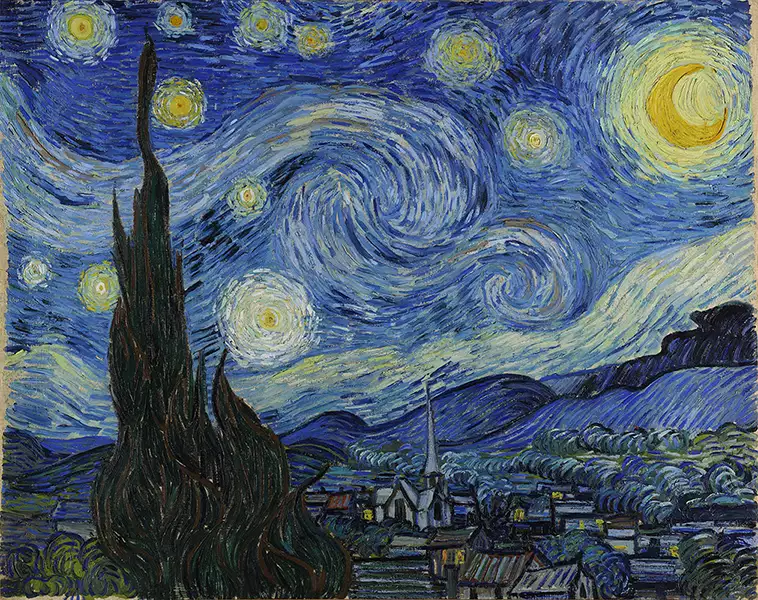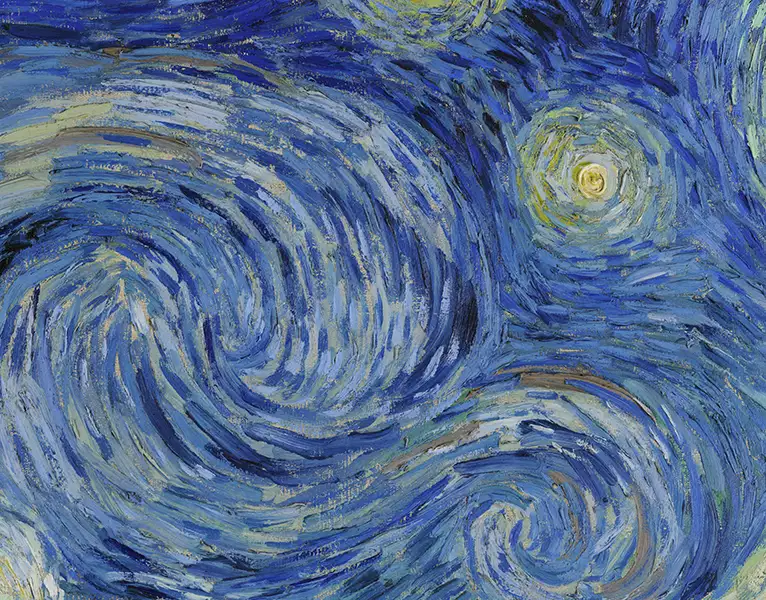The Starry Night is one of the most iconic works of Post-Impressionism and a visual testament to the tormented genius of Vincent van Gogh. This painting, created in 1889 during his stay at the Saint-Paul-de-Mausole asylum in Saint-Rémy-de-Provence, France, transcends its aesthetic function and immerses us in a world of emotion, dynamism, and subjectivity. With its distinctive style of vibrant brushstrokes and its almost dreamlike interpretation of the landscape, the work stands as a key milestone in the history of Western art.
Since its creation, The Starry Night has been the subject of countless interpretations, ranging from psychological readings to formal and symbolic analyses. This painting has influenced artists, filmmakers, and poets, becoming a universal symbol of the creator’s internal struggle against the beauty and despair of the world.
In this extensive analysis, we will explore each of the elements that compose this magnificent work—from its technique and composition to its iconography and meaning. To that end, we will break down its structure into several detailed sections:
- Technical Data: Essential information about the work.
- Technical Elements: Support, technique, and brushwork.
- Formal Elements: Composition, lines, and visual structure.
- Color: Use of color, color range, and contrasts.
- Treatment of Light: Lighting and its impact on the work.
- Space: Depth and treatment of the surroundings.
- Iconographic Analysis: Interpretation of the symbolic elements and their context.
Before delving into the detailed analysis, it is essential to situate the work within Van Gogh’s personal context and the artistic movement to which it belongs. The story behind The Starry Night is as fascinating as the painting itself, as it reflects the artist’s emotional state at a crucial moment in his life.
Image: Vincent van Gogh in 1889 (Place to insert an image of the artist from the year the work was created).
The work not only captures a nocturnal landscape with extraordinary technique but also conveys an intense emotional and psychological charge. Through his vibrant strokes and his unique way of representing reality, Van Gogh transports us into his inner world—full of turbulence, dreams, and a constant search for meaning.
Now, let us begin our analysis with the technical data of the work.
Technical Data of The Starry Night
Below, we present the technical data of The Starry Night, one of Vincent van Gogh’s masterpieces:
- Type of Work: Pictorial, oil on canvas.
- Title: The Starry Night (De sterrennacht in Dutch).
- Author: Vincent van Gogh.
- School, Style, or Movement: Post-Impressionism.
- Approximate Date: June 1889.
- Museum, Collection, or Location: Museum of Modern Art (MoMA), New York, United States.
- Dimensions: 73.7 cm × 92.1 cm.
- Signature: The work is not signed.
Image: The Starry Night (Recommendation: insert an image of the work here to illustrate this section).
This technical data provides an overview of the essential aspects of the work. However, to fully understand its relevance and artistic richness, we must analyze it in depth from technical, formal, and symbolic perspectives. Let us continue with the technical analysis.
Technical Elements
The technique employed in The Starry Night is a clear demonstration of Vincent van Gogh’s virtuosity in using oil on canvas. This medium allowed the artist to achieve a unique chromatic intensity with a pasty texture characteristic of his style. The impasto technique, which consists of applying thick layers of paint, is one of the most prominent aspects of the work, as it not only adds volume and dynamism but also creates a tactile experience that invites the viewer to almost “feel” the painting with their eyes.
The support used—a canvas of medium dimensions (73.7 cm × 92.1 cm)—was prepared with a neutral base color to highlight the vibrancy of the applied tones. Van Gogh’s thick, deliberate brushstrokes are the most recognizable element of his technique. These short, undulating strokes create a visual rhythm that traverses the entire surface of the painting, from the swirls in the sky to the details in the terrestrial landscape. This constant movement in the pictorial texture reinforces the sense of dynamism and energy that permeates the work.
Van Gogh employed brushes of various sizes to achieve differentiated effects. In the sky, the strokes are broad and curved, forming spirals and swirls that bring life to the stars and the moon. In contrast, in the houses of the small village, the strokes are more controlled, creating geometric shapes that add stability and serenity to the overall composition. This contrast between the turbulent sky and the tranquil landscape reflects an emotional tension that can be seen as a mirror of the artist’s state of mind.
The choice of vibrant colors and the application of dense layers of paint are also essential to the technique of this work. Each brushstroke seems carefully laden with intention, demonstrating Van Gogh’s absolute control over his medium, despite its apparent spontaneity. The resulting texture is not only a visual delight but also interacts with light in a particular way, creating reflections and shadows that vary depending on the angle from which it is observed.
The high level of technical detail in The Starry Night reveals a deep reflection on the part of Van Gogh regarding the use of oil as an expressive tool. Through his technique, he transforms a nocturnal landscape into an almost mystical experience, where every brushstroke seems imbued with a life of its own.
Formal Elements
The composition of The Starry Night stands out for its dynamic and deeply expressive structure, where every element appears to be in constant motion. Although at first glance the work might seem chaotic, a closer analysis reveals a careful and deliberate organization. The arrangement of the figures and landscape elements is designed to guide the viewer’s gaze through the scene, starting with the turbulent sky and descending toward the tranquil village in the lower plane.
At the center of the composition, the nocturnal sky dominates most of the canvas, unfolding swirls, spirals, and stars that seem to radiate energy. The curving, undulating lines create an almost hypnotic effect, while the cypress tree rising from the foreground acts as a visual axis connecting the sky and the earth. This vertical element breaks the predominant horizontality of the landscape and serves as a bridge between the two represented worlds: the vibrant cosmos and the earthly serenity.
The composition can be considered predominantly diagonal and asymmetrical. The lines that trace the swirls in the sky and the tilt of the hills generate a sense of continuous movement that contrasts with the static forms of the village. The houses, small and orderly, are arranged in a horizontal line that reinforces the stability of the terrestrial plane. This contrast between the turbulence of the sky and the calm of the village reflects an emotional duality that pervades the entire work.
Another important aspect of the formal elements is the lines that structure the composition. Van Gogh uses curved lines to define the sky, imbuing it with fluidity and dynamism, while the straight, angular lines in the houses and the village church suggest order and stability. This interplay between the organic and the geometric not only enriches the work visually but also reinforces its symbolic character, presenting a dichotomy between cosmic chaos and human calm.
In terms of scale, the cypress and the church are particularly noteworthy. Although the cypress might seem disproportionate in relation to the village, this intentional exaggeration gives it a symbolic role—perhaps as a spiritual connection or an earthly anchor amid the cosmic vastness. The church tower, on the other hand, with its pronounced verticality, acts as a visual echo of the cypress, reinforcing the compositional balance.
Finally, it is important to mention the mountainous background that stretches toward the horizon. Although it appears less prominent than the sky and the village, it plays a crucial role in the composition by dividing the two planes and providing a sense of depth. This background, with its soft, undulating lines, serves as a transition between the dynamism of the sky and the structured calm of the village.
The careful organization of the elements in The Starry Night demonstrates Van Gogh’s mastery of composition, managing to balance apparent chaos with an underlying structure that guides the viewer through the work in a fluid and engaging manner.
Color
Color in The Starry Night is one of the most striking and significant aspects of the work, playing a fundamental role in conveying its emotional and symbolic atmosphere. Van Gogh uses a predominantly cool palette, dominated by blue tones that cover the sky, the mountains, and much of the terrestrial landscape. This use of blue not only creates a sense of calm and serenity but also evokes an almost infinite depth, inviting the viewer to lose themselves in the vastness of the cosmos.
However, this apparent calm is contrasted by the vibrant warm tones of the stars and the moon, which stand out intensely against the dark background of the sky. The yellows and oranges used in these celestial elements not only add light and dynamism but also serve as focal points that guide the viewer’s gaze through the composition. This contrast between warm and cool colors creates a striking visual effect, reinforcing the duality between movement and stillness that defines the work.
An interesting aspect of the color in The Starry Night is the use of gradations and blends. In the sky, Van Gogh employs smooth transitions between blue and white tones to create the swirls and spirals that seem to move continuously. These blends not only add depth to the sky but also contribute to the sense of fluid energy that permeates the work. Despite the intense chromaticity, the treatment of color in the sky maintains a certain harmony that contrasts with the more restrained brushstrokes of the village.
On the terrestrial plane, the colors are more muted and earthy, with dark tones of green, brown, and gray underlining the tranquility and stability of the village. The warm lights from the windows, though small, add a human touch to the landscape, reminding us of the presence of life amid this cosmic scene. This chromatic contrast between the sky and the earth not only separates the two planes but also emphasizes the spiritual connection between them.
The treatment of color in the work also carries an important symbolic component. Blue, for example, can be interpreted as a symbol of introspection, melancholy, or spirituality, while the yellows and oranges of the stars and the moon might represent hope, energy, or the divine. This chromatic symbolism, though subjective, adds a layer of meaning that connects the viewer with Van Gogh’s emotional state at the time of the painting’s creation.
Overall, the color in The Starry Night is not only a technical means of representing the scene but also an expressive tool that allows the artist to convey his subjective vision of the world. The vibrant interplay between warm and cool tones, along with the richness of the blends and contrasts, transforms this work into a visual spectacle imbued with emotion and symbolism.
Treatment of Light
Light plays a fundamental role in The Starry Night, serving not only as a visual element but also as an expressive and symbolic resource that brings the scene to life. Although it is a nocturnal representation, the work is filled with luminosity—a contrast that defies realistic conventions and underscores the subjective and emotional character of Van Gogh’s art. The light in this painting seems to emanate from two main sources: the celestial bodies in the sky and the illuminated windows of the village.
In the sky, the light of the stars and the moon is not confined to small bright points; instead, Van Gogh depicts them as expansive, dynamic halos that dominate the composition. Each star appears to radiate energy in the form of concentric circles, as if emitting vibrations that propagate through the atmosphere. This unique treatment of light not only adds a sense of movement to the scene but also emphasizes the cosmic connection that Van Gogh sought to express. The moon, with its large yellow halo, becomes one of the most striking elements, casting a warm glow that contrasts with the cool tones of the sky.
On the other hand, the light from the village is more subtle and controlled. The small, illuminated windows suggest life and human warmth in contrast to the vastness and dynamism of the sky. These earthly lights, though discreet, have a significant impact by adding a touch of intimacy and reality to the scene, balancing the ethereal atmosphere of the cosmos with a sense of home and humanity.
The use of light in The Starry Night is not naturalistic but rather symbolic and expressive. Instead of depicting uniform or realistic lighting, Van Gogh uses light to create dramatic contrasts that enhance the emotional atmosphere of the work. Light is not bound by physical laws; rather, it appears charged with emotional energy, flowing and vibrating along with the artist’s brushstrokes.
Furthermore, the interplay between light and shadow is notable in the treatment of the landscape. Although the sky is predominantly luminous, the hills and trees stretching toward the horizon are immersed in deep shadows, creating a contrast that reinforces the sense of depth and three-dimensionality. The cypress, with its dark, elongated silhouette, acts as a visual counterbalance to the bright lights of the sky, drawing the viewer’s attention upward and symbolically connecting the terrestrial with the celestial.
Ultimately, the treatment of light in The Starry Night is one of the features that distinguishes it as a masterpiece of Post-Impressionism. Through its expressive and symbolic use, Van Gogh transforms a nocturnal landscape into a deeply emotional and almost spiritual experience, inviting the viewer to reflect on the connection between humanity, nature, and the universe.

Space
The treatment of space in The Starry Night is fundamental to understanding the emotional and visual depth of the work. Although the landscape is based on an actual view from the window of the asylum in Saint-Rémy-de-Provence, Van Gogh did not confine himself to an objective representation of space; rather, he reinterpreted it to create a scene laden with symbolism and dynamism. The work achieves a remarkable sense of depth and three-dimensionality through the use of various compositional resources and pictorial techniques.
In the upper plane, the sky occupies most of the canvas, becoming the absolute protagonist of the scene. The undulating forms and swirls of clouds and stars create an apparently infinite space that seems to extend beyond the frame’s limits. This sky is not static; each element appears to be in constant motion, as if the celestial space were alive and vibrating. The depth is further intensified by the overlapping of elements such as the spirals and halos of light surrounding the stars, which provides a sense of atmospheric perspective.
The middle plane is composed of the hills and mountains that extend on the horizon. These soft, undulating forms serve as a transition between the dynamic sky and the more static village in the lower plane. Although the mountains are not precisely delineated, their wavering silhouette reinforces the overall fluidity of the composition. Additionally, the brushstrokes in this area are shorter and less defined, creating a sense of distance and separation from the foreground.
In the lower plane, the village introduces a more contained and organized space. The houses, represented by simple geometric shapes, are arranged in an orderly fashion, creating a strong contrast with the agitation of the sky. Despite their simplicity, these structures impart a sense of stability and realism to the work. The church’s bell tower, with its elongated and vertical form, acts as a connecting element between the terrestrial plane and the sky, reinforcing the idea of a symbolic union between the two worlds.
A prominent element in the depicted space is the cypress in the foreground. Its commanding position and disproportionate size relative to the rest of the landscape make it a focal point that directs the gaze upward toward the sky. Its dark, ascending silhouette not only adds depth to the space but also introduces a sense of monumentality that contrasts with the small figures of the village.
In addition to these primary planes, Van Gogh employs perspective techniques to add three-dimensionality to the work. Although he does not rely on strict linear perspective, he uses the arrangement of elements and the variation in the size and clarity of forms to suggest a progression from the foreground to the background. For instance, the houses in the village become smaller and less detailed as they recede toward the horizon, which contributes to the sense of distance.
Conclusion
The Starry Night is much more than a painting; it is a visual testament to the emotional and spiritual complexity of Vincent van Gogh. Through its vibrant technique, carefully designed composition, and symbolism laden with meaning, the work transcends the limits of Post-Impressionism to become a universal reflection on the connection between human beings and the cosmos. In this nocturnal landscape, Van Gogh demonstrates his unique ability to transform his inner torment into an experience of beauty and transcendence that continues to captivate generations. In observing this work, we witness not only a celestial scene but also a fragment of the soul of an artist who found in art his way of communicating with the eternal.

The Starry Night – Vincent van Gogh
Vincent van Gogh’s *The Starry Night* (1888) is a stunning example of Post-Impressionism, showcasing the emotional depth and beauty of a night sky. Created during his stay in Arles, France, this iconic piece features a swirling, luminous sky filled with stars and a crescent moon, all radiating a celestial energy that captivates the viewer. The bold brushstrokes in vibrant shades of blue, yellow…


